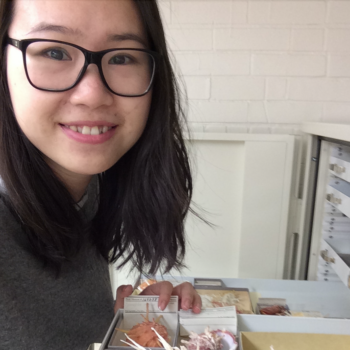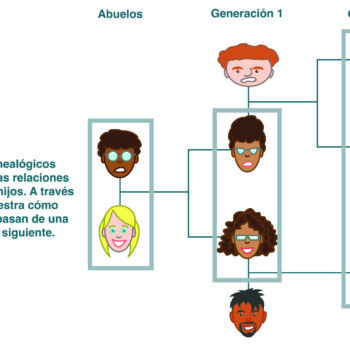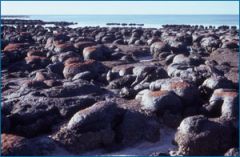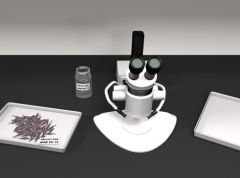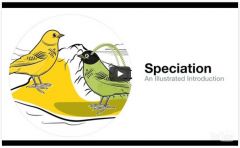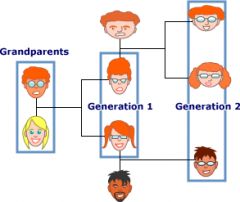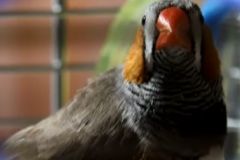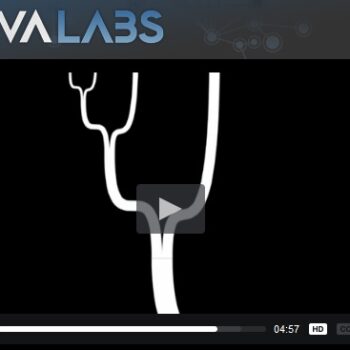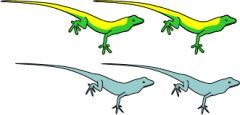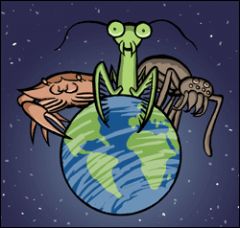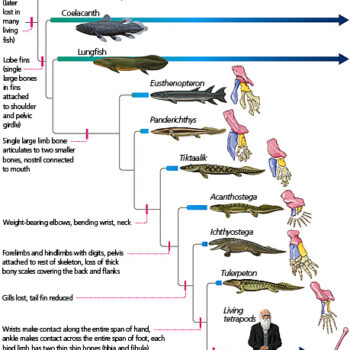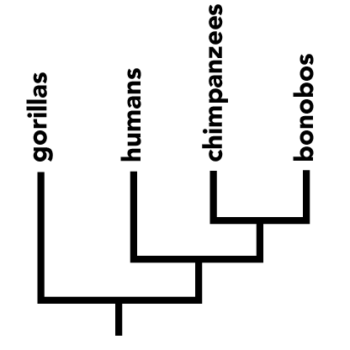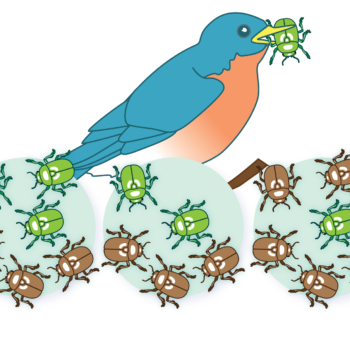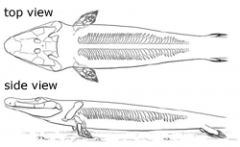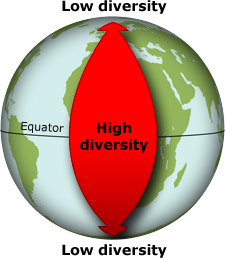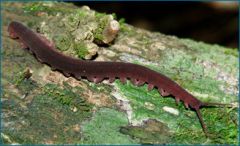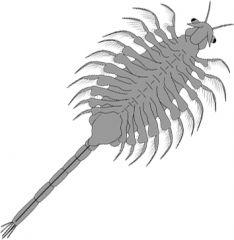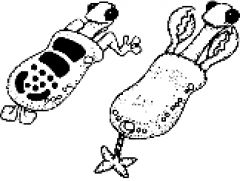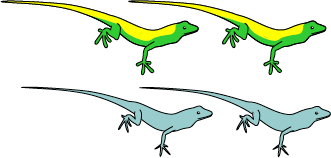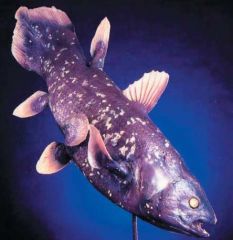Search by:
Found 32 resources:
Extinction vulnerability with Shan Huang, David Jablonski, and Stewart Edie
Grade Level(s):
- 9-12
- 13-16
Source:
- UC Museum of Paleontology
Resource type:
- Article
- Classroom activity
Time: 1.5 hrs
Overview
In this article (and the linked assignments and student readings), students examine and interpret data that Shan, David, and Stewart used to investigate whether the mollusk species that humans eat are inherently vulnerable to extinction. Use the tabs at the bottom of the feature to find related videos, assignments, and lessons to build this example into a lesson sequence on extinction.
Semejanzas y diferencias: Comprendamos las homologías y evolución convergente (nivel secundaria)
Grade Level(s):
- 6-8
Source:
- UC Museum of Paleontology
Resource type:
- Online activity or lab
Time: 30 minutes
Overview
Esta investigación interactiva explica qué son las homologías, cómo reconocerlas y cómo es que evolucionan.
Semejanzas y diferencias: Comprendamos las homologías y evolución convergente (nivel bachillerato)
Grade Level(s):
- 9-12
Source:
- UC Museum of Paleontology
Resource type:
- Online activity or lab
Time: 30 minutes
Overview
Esta investigación interactiva explica qué son las homologías, cómo reconocerlas y cómo es que evolucionan.
La historia de la vida: La observación de los patrones
Grade Level(s):
- 9-12
Source:
- UC Museum of Paleontology
Resource type:
- Tutorial
Time: 30-40 minutes
Overview
La ciencia usa muchas evidencias diferentes para reconstruir los árboles filogenéticos que nos muestran como se relacionan las especies entre sí.
Este artículo se encuentra en Evolución 101.
Del caldo primigenio a las células: El origen de la vida
Grade Level(s):
- 9-12
Source:
- UC Museum of Paleontology
Resource type:
- Tutorial
Time: 20 minutes
Overview
Profundiza en los conocimientos actuales sobre el origen de la vida y en cómo los científicos y las científicas son capaces de investigar en los detalles de acontecimientos tan antiguos.
From soup to cells – The origin of life
Grade Level(s):
- 9-12
Source:
- UC Museum of Paleontology
Resource type:
- Tutorial
Time: 20 minutes
Overview
Delve into our current understandings of the origins of life and how scientists are able to investigate the details of such ancient events.
This article is located within Evolution 101.
Stickleback Evolution Virtual Lab
Grade Level(s):
- 9-12
- 13-16
Source:
- Howard Hughes Medical Institute
Resource type:
- Online activity or lab
Time: 3 hours
Overview
This virtual lab teaches skills of data collection and analysis to study evolutionary processes using stickleback fish and fossil specimens.
Speciation: An illustrated introduction
Grade Level(s):
- 6-8
- 9-12
- 13-16
Source:
- TED-ed
Resource type:
- Video
Time: 15 minutes
Overview
This video illustrates the speciation process in birds to help explain the basis of earth's biodiversity. Registration may be required to view the discussion and multiple choice questions that accompany the video.
Similarities and differences: Understanding homology and convergent evolution
Grade Level(s):
- 9-12
Source:
- UC Museum of Paleontology
Resource type:
- Online activity or lab
Time: 30 minutes
Overview
This interactive investigation explains what homologies are, how to recognize them, and how convergent traits evolve.
Predicting evolutionary relationships
Grade Level(s):
- 9-12
Source:
- NOVA
Resource type:
- Classroom activity
Time: 1 hour
Overview
Students compare the sequence of amino acids in a gene shared between humans and six other organisms and infer evolutionary relationships among the species.
The Evolution Lab
Grade Level(s):
- 9-12
Source:
- NOVA Labs
Resource type:
- Lab activity
Time: 3 hours
Overview
The Evolution Lab contains two main parts. In the first, students build phylogenetic trees themed around the evidence of evolution, including fossils, biogeography, and similarities in DNA. In the second, students explore an interactive tree of life and trace the shared ancestry of numerous species.
It takes teamwork: How endosymbiosis changed life on Earth
Grade Level(s):
- 9-12
- 13-16
Source:
- UC Museum of Paleontology
Resource type:
- Article
Time: 30-40 minutes
Overview
You might be surprised to learn that descendants of an ancient bacterium are living in every cell of your body! Find out how endosymbiosis factored into the evolution of your own cells and learn about a modern example of this process.
Island biogeography and evolution: Solving a phylogenetic puzzle using molecular genetics
Grade Level(s):
- 9-12
- 13-16
Source:
- Filson, R.P.
Resource type:
- Lab activity
Time: Two full class periods
Overview
Students focus on the evolution of three species of lizards using real data sets — geographical and geological data, then morphology, and finally molecular data — to determine possible phylogenetic explanations.
Interactive investigation: The arthropod story
Grade Level(s):
- 6-8
- 9-12
Source:
- UC Museum of Paleontology
Resource type:
- Online activity or lab
Time: 3-4 class periods
Overview
This interactive investigation delves into the amazing world of the arthropods and examines their success and their evolutionary constraints.
Understanding Macroevolution Through Evograms
Grade Level(s):
- 9-12
- 13-16
Source:
- UC Museum of Paleontology
Resource type:
- Article
Time: 1 hour
Overview
Evograms convey information about how a group of organisms and their particular features evolved. This article explains how to read evograms and delves into the evolutionary history of whales, tetrapods, mammals, birds, and humans.
Evolutionary trees and patterns in the history of life
Grade Level(s):
- 9-12
Source:
- UC Museum of Paleontology
Resource type:
- Tutorial
Time: 30-40 minutes
Overview
Scientists use many different lines of evidence to reconstruct the evolutionary trees that show how species are related.
This article is located within Evolution 101.
Evolution of human skin color
Grade Level(s):
- 9-12
- 13-16
Source:
- Smithsonian National Museum of Natural History
Resource type:
- Classroom activity
Time: Seven to ten 50 minute class periods
Overview
Students examine evidence for the relationship between UV and melanin in other animals; investigate the genetic basis for constitutive skin color humans; learn to test for natural selection in mouse fur color; investigate how interactions between UV and skin color in humans can affect fitness; and explore data on migrations and gene frequency to show convergent evolution of skin color.
Evolution 101
Grade Level(s):
- 9-12
- 13-16
Source:
- UC Museum of Paleontology
Resource type:
- Tutorial
Time: multiple days
Overview
This in-depth, multi-part course takes you through evolutionary theory and mechanisms, from definitions to details, natural selection to genetic drift, mutations to punctuated equilibrium.
Evolución 101
Grade Level(s):
- 9-12
- 13-16
Source:
- UC Museum of Paleontology
Resource type:
- Article
Overview
¿Qué es la evolución y cómo funciona? Introducción a la evolución ofrece información detallada y práctica sobre los patrones y los mecanismos de la evolución.
Evo in the news: Where species come from
Grade Level(s):
- 9-12
- 13-16
Source:
- UC Museum of Paleontology
Resource type:
- Evo in the News article
Time: 15 minutes
Overview
Lush tropical ecosystems house many times more species than temperate or Arctic regions. This news brief from November 2006 discusses the evolutionary explanation for this diversity trend and reveals why threats to tropical ecosystems may threaten diversity on a global scale.
Evo in the news: What has the head of a crocodile and the gills of a fish?
Grade Level(s):
- 9-12
- 13-16
Source:
- UC Museum of Paleontology
Resource type:
- Evo in the News article
Time: 15 minutes
Overview
This news brief, from May 2006, reviews what is likely to be the most important fossil find of the year: Tiktaalik helps us understand how our own ancestors crawled out of the water and began to walk on dry land.
Visualizing life on Earth: Data interpretation in evolution
Grade Level(s):
- 9-12
- 13-16
Source:
- UC Museum of Paleontology
Resource type:
- Online activity or lab
Time: 2 hours
Overview
This web-based module leads students through an exploration of the patterns in the diversity of life across planet Earth. Students are scaffolded as they practice data interpretation and scientific reasoning skills.
Evo in the news: The evidence lines up in early mammal evolution
Grade Level(s):
- 9-12
- 13-16
Source:
- UC Museum of Paleontology
Resource type:
- Evo in the News article
Time: 15 minutes
Overview
This news brief, from September 2011, describes the discovery of a new mammal species that highlights just how long mammals have been around. Back in the Jurassic, dinosaurs may have dominated terrestrial ecosystems, but they were not alone. Scurrying around their feet and clinging to the trees above them were the fuzzy ancestors of their successors.
Evo in the news: A new old animal
Grade Level(s):
- 9-12
- 13-16
Source:
- UC Museum of Paleontology
Resource type:
- Evo in the News article
Time: 20 minutes
Overview
A new species of velvet worm was recently discovered in Vietnam. This news brief from September 2013 describes the key position of velvet worms in evolutionary history and how they help us better understand the fossil record of the Cambrian period.
Diversity Walk
Grade Level(s):
- 3-5
Source:
- UC Museum of Paleontology
Resource type:
- Classroom activity
Time: One class period
Overview
In this lesson, students take a walk around the school grounds to discover the diversity of life that exists there.
Diversity
Grade Level(s):
- K-2
Source:
- Janulaw, Sharon
Resource type:
- Classroom activity
Time: 30 minutes each for three sessions
Overview
Students learn that there are many forms of living things by going for a walk and by observing living things in the classroom.
Coping with Environmental Differences
Grade Level(s):
- 3-5
Source:
- UC Museum of Paleontology
Resource type:
- Classroom activity
Time: One class period for initial set up. Approx. 10-15 minutes for daily observations.
Overview
Students will observe and conduct an experiment to see whether differences in salinity (the environment) have an affect on the hatching rate and survival of brine shrimp.
Classification and Evolution
Grade Level(s):
- 9-12
- 13-16
Source:
- Gendron, Robert
Resource type:
- Lab activity
Time: Two class periods.
Overview
Students construct an evolutionary tree of imaginary animals (Caminalcules) to illustrate how modern classification schemes attempt to reflect evolutionary history.
Anolis Lizards
Grade Level(s):
- 9-12
Source:
- Collins, Jennifer
Resource type:
- Lab activity
Time: Two class periods.
Overview
Students "take a trip" to the Greater Antilles to figure out how the Anolis lizards on the islands might have evolved.
What does it mean to be human?
Grade Level(s):
- 9-12
- 13-16
Source:
- Smithsonian National Museum of Natural History
Resource type:
- Classroom activity
Time: 8 x 50-minute class periods
Overview
In this set of advanced lessons, students use different types of data to infer/interpret phylogenies among domains, within the vertebrates, and within primates while reflecting on how they answer the question "What do you think it means to be human?" and choose a characteristic that changed substantially in the human family tree to develop a scientific argument based on evidence for when the character evolved.
Adaptation to altitude
Grade Level(s):
- 9-12
- 13-16
Source:
- Smithsonian National Museum of Natural History
Resource type:
- Classroom activity
Time: Eight 50-minute class periods
Overview
In this set of sequenced lessons, students learn how to devise an experiment to test the difference between acclimation and adaptation; investigate how scientific arguments show support for natural selection in Tibetans; design an investigation using a simulation based on the Hardy-Weinberg principle to explore mechanisms of evolution; and devise a test for whether other groups of people have adapted to living at high altitudes.
A Strange Fish Indeed: The “Discovery” of a Living Fossil
Grade Level(s):
- 9-12
- 13-16
Source:
- Grant, Robert
Resource type:
- Classroom activity
Time: 50-90 min.
Overview
Through a series of fictionalized diary entries, this case recounts the 1939 discovery by Marjorie Courtenay-Latimer (and identification by J.L.B. Smith) of a living coelacanth, a fish believed to have been extinct for 70 million years.

